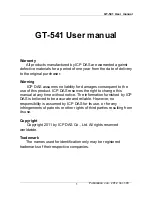
Chapter 5 Broadband
P-661HNU-Fx User’s Guide
108
Unspecified Bit Rate (UBR)
The Unspecified Bit Rate (UBR) ATM traffic class is for bursty data transfers.
However, UBR doesn't guarantee any bandwidth and only delivers traffic when the
network has spare bandwidth. An example application is background file transfer.
IP Address Assignment
A static IP is a fixed IP that your ISP gives you. A dynamic IP is not fixed; the ISP
assigns you a different one each time. The Single User Account feature can be
enabled or disabled if you have either a dynamic or static IP. However the
encapsulation method assigned influences your choices for IP address and default
gateway.
Introduction to VLANs
A Virtual Local Area Network (VLAN) allows a physical network to be partitioned
into multiple logical networks. Devices on a logical network belong to one group. A
device can belong to more than one group. With VLAN, a device cannot directly
talk to or hear from devices that are not in the same group(s); the traffic must
first go through a router.
In Multi-Tenant Unit (MTU) applications, VLAN is vital in providing isolation and
security among the subscribers. When properly configured, VLAN prevents one
subscriber from accessing the network resources of another on the same LAN,
thus a user will not see the printers and hard disks of another user in the same
building.
VLAN also increases network performance by limiting broadcasts to a smaller and
more manageable logical broadcast domain. In traditional switched environments,
all broadcast packets go to each and every individual port. With VLAN, all
broadcasts are confined to a specific broadcast domain.
Multicast
IP packets are transmitted in either one of two ways - Unicast (1 sender - 1
recipient) or Broadcast (1 sender - everybody on the network). Multicast delivers
IP packets to a group of hosts on the network - not everybody and not just 1.
Internet Group Multicast Protocol (IGMP) is a network-layer protocol used to
establish membership in a Multicast group - it is not used to carry user data. IGMP
version 2 (RFC 2236) is an improvement over version 1 (RFC 1112) but IGMP
version 1 is still in wide use. If you would like to read more detailed information
about interoperability between IGMP version 2 and version 1, please see sections
4 and 5 of RFC 2236. The class D IP address is used to identify host groups and
can be in the range 224.0.0.0 to 239.255.255.255. The address 224.0.0.0 is not
assigned to any group and is used by IP multicast computers. The address
Summary of Contents for P-661H-61
Page 2: ......
Page 8: ...Safety Warnings P 661HNU Fx User s Guide 8...
Page 10: ...Contents Overview P 661HNU Fx User s Guide 10...
Page 18: ...Table of Contents P 661HNU Fx User s Guide 18 Appendix G Legal Information 393 Index 1...
Page 19: ...19 PART I User s Guide...
Page 20: ...20...
Page 28: ...Chapter 1 Introduction P 661HNU Fx User s Guide 28...
Page 36: ...Chapter 2 Introducing the Web Configurator P 661HNU Fx User s Guide 36...
Page 79: ...79 PART II Technical Reference...
Page 80: ...80...
Page 86: ...Chapter 4 Connection Status and System Info Screens P 661HNU Fx User s Guide 86...
Page 140: ...Chapter 6 Wireless P 661HNU Fx User s Guide 140...
Page 172: ...Chapter 8 Routing P 661HNU Fx User s Guide 172...
Page 176: ...Chapter 9 DNS Route P 661HNU Fx User s Guide 176...
Page 260: ...Chapter 24 Backup Restore P 661HNU Fx User s Guide 260...
Page 281: ...Chapter 27 Product Specifications P 661HNU Fx User s Guide 281...
Page 282: ...Chapter 27 Product Specifications P 661HNU Fx User s Guide 282...
Page 334: ...Appendix C Pop up Windows Java Script and Java Permissions P 661HNU Fx User s Guide 334...
Page 358: ...Appendix D Wireless LANs P 661HNU Fx User s Guide 358...
Page 392: ...Appendix F Open Software Announcements P 661HNU Fx User s Guide 392...
Page 403: ...Index P 661HNU Fx User s Guide 403...
Page 404: ...Index P 661HNU Fx User s Guide 404...
















































